Best Wi-Fi Cards for Desktops 2024: Wi-Fi 6, Wi-Fi 6E, and Wi-Fi 7
From Wi-Fi 6 to Wi-Fi 7, we have you covered on wireless adapters for your desktop
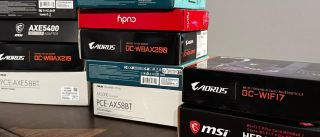
Wireless connectivity has become a given for mobile computing in today’s society, particularly with smartphones, laptops, and smart home devices. However, it’s not necessarily a foregone conclusion that desktop computers come standard with Wi-Fi connectivity.
While some prebuilt desktops and motherboards include integrated Wi-Fi, many users needing wireless connectivity must opt for an add-in card or USB Wi-Fi dongle . You may also want a Wi-Fi card if your desktop came with built-in Wi-Fi 5 or 6 and now you want to upgrade to a newer standard. Luckily, a wide variety of cards are available covering the three most recent Wi-Fi standards: Wi-Fi 6, Wi-Fi 6E, and Wi-Fi 7.
Quick List
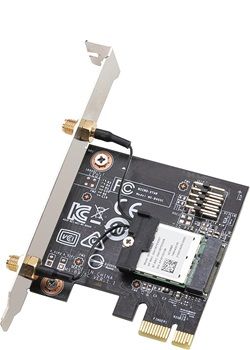
Best Wi-Fi 7 PCIe Adapter
Our overall speed champion is the MSI Herald BE, which is a PCIe Wi-Fi adapter with an optional Bluetooth 5.4 module. It blazed through our iPer3 tests, surpassing 2,800 Mbps at close range, and has a price tag of just $50.
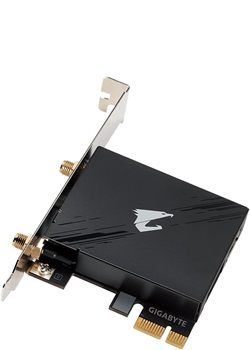
Best Wi-Fi 6E PCIe Adapter
The GC-WBAX210 wasn’t the fastest Wi-Fi 6E card we tested, but its performance was near the top of the charts. Better yet, the card is priced at just $39, making it an excellent bargain for those not yet ready to make the full transition to Wi-Fi 7 gear.
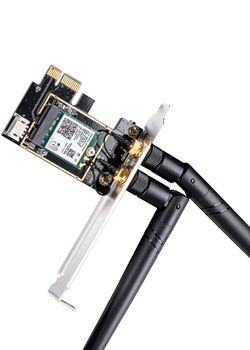
Best Wi-Fi 6 PCIe Adapter
The Cudy name might not be familiar, but the company’s AX3000 Wi-Fi 6 adapter has the basics right, thanks to an Intel AX200 NGFF 2230 M.2 Wi-Fi chip. And with a $26 price tag, it won’t break the bank.
Best Wi-Fi Cards for Desktops You Can Buy Today
Why you can trust Tom's Hardware
Best Wi-Fi 7 PCIe Adapter
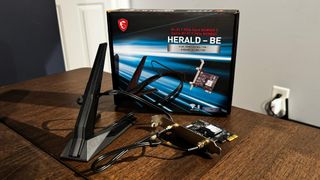
1. MSI Herald BE
Specifications
Reasons to buy
Reasons to avoid
The MSI Herald BE topped our leaderboard on the 6 GHz band when using Wi-Fi 7. It achieved over 2,800 Mbps at close range with uncongested traffic and only dropped to just over 2,700 Mbps at long range (25 feet). That consistent performance continued with our congested tests.
The wireless adapter has an external antenna attached to a 2.5-foot cable, allowing you to magnetically attach it to the top of your PC’s enclosure or desk. The adapter sports a theoretical maximum transfer speed of 5.8 Gbps (we saw roughly half that maximum) and includes a USB cable in the box that connects to your motherboard to enable Bluetooth 5.4 support.
With a price tag of $49.99, the MSI Herald BE is an easy-to-recommend upgrade to add Wi-Fi 7 to your desktop PC.
| Header Cell - Column 0 | Near (Mbps) | Far (Mbps) |
|---|---|---|
| iPerf3 Uncongested 6 GHz | 2830 | 2730 |
| iPerf3 Uncongested 5 GHz | 1830 | 1373 |
| iPerf3 Uncongested 2.4 GHz | 187 | 131 |
| iPerf3 Congested 6 GHz | 2566 | 2060 |
| iPerf3 Congested 5 GHz | 1290 | 1005 |
| iPerf3 Congested 2.4 GHz | 166 | 100 |
Best Wi-Fi 6E PCIe Adapter
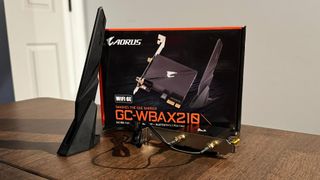
2. Gigabyte GC-WBAX210
Specifications
Reasons to buy
Reasons to avoid
The Gigabyte GC-WBAX210 is a great, all-around Wi-Fi 6E adapter. At its fastest (6-feet, uncongested traffic), the GC-WBAX210 topped out at nearly 1,900 Mbps on the 6 GHz band. But even at 25 feet, performance was still admirable at around 1,700 Mbps. 5 GHz performance was equally as good.
While it didn’t have the highest performance for a Wi-Fi 6E adapter (that honor goes to the Asus PCE-AXE58BT, the GC-WBAX210 costs just $39 compared to $59 for the Asus. That extra $20 isn’t worth the few percentage points in difference separating the two cards.
We should also note that the GC-WBAX210 includes a USB cable that plugs into the card to enable Bluetooth 5.2 for your supported devices.
| Header Cell - Column 0 | Near (Mbps) | Far (Mbps) |
|---|---|---|
| iPerf3 Uncongested 6 GHz | 1870 | 1696 |
| iPerf3 Uncongested 5 GHz | 1790 | 1510 |
| iPerf3 Uncongested 2.4 GHz | 160 | 127 |
| iPerf3 Congested 6 GHz | 1500 | 1163 |
| iPerf3 Congested 5 GHz | 1446 | 947 |
| iPerf3 Congested 2.4 GHz | 132 | 85 |
Best Wi-Fi 6 PCIe Adapter
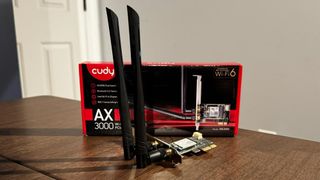
3. Cudy AX3000
Specifications
Reasons to buy
Reasons to avoid
Cudy might be a brand few people are familiar with, but the AX3000 Wi-FI 6 adapter gets the job done. It uses an Intel AX200 NGFF 2230 M.2 card and a standard PCIe adapter card. The antennas screw directly into the back of the card without an extension.
Its overall performance was strong among the Wi-Fi 6 competition, and we can’t argue with its price tag of just $26. That price also includes a half-height/low-profile PCI bracket for use in more compact systems, a driver CD, and a screwdriver in the box to aid in installation. Some of the Wi-Fi adapters we tested that are twice this price don’t even include those extra pack-ins.
| Header Cell - Column 0 | Near (Mbps) | Far (Mbps) |
|---|---|---|
| iPerf3 Uncongested 5 GHz | 1363 | 823 |
| iPerf3 Uncongested 2.4 GHz | 167 | 118 |
| iPerf3 Congested 5 GHz | 1123 | 1120 |
| iPerf3 Congested 2.4 GHz | 101 | 98 |
Best Wi-Fi USB Adapter

4. MSI AXE5400
Specifications
Reasons to buy
Reasons to avoid
The MSI AXE5400 is one of the two USB solutions we’ve tested so far, and it uses the Wi-Fi 6E standard. At first, it looks like a large USB thumb drive, but you’ll notice it has a flip-out antenna that sweeps 180 degrees. In addition, MSI provides a stand for the wireless adapter in the box with a 2.5-foot-long USB cable, allowing you to place the AXE5400 where you prefer for the best reception.
Regarding performance, the USB 3.0 interface blunts performance by about 20 percent compared to the best PCIe Wi-Fi 6E adapters we tested. However, we’re still talking Gig+ speeds, which should be sufficient for most home users. It’s also reasonably priced at just $51.
| Header Cell - Column 0 | Near (Mbps) | Far (Mbps) |
|---|---|---|
| iPerf3 Uncongested 6 GHz | 1350 | 1183 |
| iPerf3 Uncongested 5 GHz | 1413 | 800 |
| iPerf3 Uncongested 2.4 GHz | 142 | 30 |
| iPerf3 Congested 6 GHz | 1320 | 1260 |
| iPerf3 Congested 5 GHz | 735 | 597 |
| iPerf3 Congested 2.4 GHz | 63 | 35 |
Best Value Wi-Fi PCIe Adapter
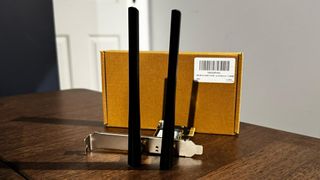
5. OKN AX5400
Specifications
Reasons to buy
Reasons to avoid
Wi-Fi 7 adapters currently offer the best performance when using the 6 GHz channel, but their Wi-Fi 6E counterparts are more than capable of delivering Gig+ speeds. When it comes to the best bang for the buck, it’s hard to get any better than the OKN AX5400. The wireless adapter provides solid performance at close range on the 6 GHz and 5 GHz bands.
The only place where the card falters is at 25-foot distances on the 5 GHz band. However, your mileage may vary depending on the layout of your home and any obstacles that may be in the way.
The best part about the OKN AX5400 is its price. At $26, it’s roughly half the price of our top pick for Wi-Fi 7 adapters and $14 less than our best Wi-Fi 6E adapter.
| Header Cell - Column 0 | Near (Mbps) | Far (Mbps) |
|---|---|---|
| iPerf3 Uncongested 6 GHz | 1670 | 1473 |
| iPerf3 Uncongested 5 GHz | 1246 | 1126 |
| iPerf3 Uncongested 2.4 GHz | 153 | 77 |
| iPerf3 Congested 6 GHz | 1650 | 1063 |
| iPerf3 Congested 5 GHz | 1036 | 590 |
| iPerf3 Congested 2.4 GHz | 130 | 87 |
PCIe Wi-Fi adapters versus USB Wi-Fi adapters
There are two primary ways for users to add Wi-Fi connectivity to a desktop. The first option is a PCIe add-in card, which offers the best performance and is typically the cheapest option. Interestingly, all the PCIe solutions feature an NGFF 2230 M.2 Wi-Fi card used in laptops that is inserted into a PCIe x1 adapter card.
The backplate of each PCIe add-in card includes two antenna ports. On some cards, moveable antennas screw directly into the back. On the rest of the cards, wire leads screw into the antenna ports, which then attach to an external antenna base that typically attaches magnetically to the top of your desktop enclosure or sits on your desk. The idea here is to give the user more control of where the antennas point to improve overall performance.


The second option is to go with a USB wireless adapter. These Wi-Fi adapters plug into a free USB port and are the quickest and easiest way to add wireless connectivity to a desktop. However, they are typically slower than their PCIe counterparts.
Another less common option is for a desktop motherboard to include an NGFF 2230 M.2 slot, allowing you to swap out Wi-Fi adapters at your leisure.
Of course, you’ll need one of the best Wi-Fi routers to get the absolute best speeds from any Wi-Fi adapter.
Wi-Fi 6 vs Wi-Fi 6E vs Wi-Fi 7
| Header Cell - Column 0 | Wi-Fi 6 | Wi-Fi 6E | Wi-Fi 7 |
|---|---|---|---|
| IEEE Standard | 802.11ax | 802.11ax | 802.11be |
| Maximum Speed | 9.6 Gbps | 9.6 Gbps | 46 Gbps |
| Data Bands | 2.4 GHz, 5 GHz | 2.4 GHz, 5 GHz, 6 GHz | 2.4 GHz, 5 GHz, 6 GHz |
| QAM | 1024-QAM | 1024-QAM | 4096-QAM |
| Channel Width | 160 MHz | 160 MHz | 320 MHz |
| Spatial Streams | 8 | 8 | 16 |
Testing Procedures for all Wi-Fi Adapters and Benchmark Results
To test each Wi-Fi adapter, we relied on an Intel Core i7-14600KF desktop with a built-in 10 GbE port on the motherboard (MSI MEG Z790 Godlike Max) acting as a server. The server was then connected to an open 10 GbE LAN port on a TP-Link Archer GE800 Wi-Fi 7 router. Each Wi-Fi adapter was then installed in a mini-tower desktop with an MSI Pro B650M-A Wi-Fi AM5 motherboard and a Ryzen 5 7600 processor running Windows 11 Home.
The Wi-Fi adapters were tested using iPerf3 on the 2.4 GHz, 5 GHz, and 6 GHz (where applicable) bands. Tests were conducted at six feet and 25 feet, with no network traffic and congested traffic (six devices running 4K YouTube video streams across all wireless bands).
We tested the following cards:
- Gigabyte GC-WIFI7 (Wi-Fi 7)
- MSI Herald-BE NCM865 (Wi-Fi 7)
- Gigabyte GC-WBAX210 (Wi-Fi 6E)
- Asus PCE-AXE58BT (Wi-Fi 6E)
- TP-Link Archer TXE72E (Wi-Fi 6E)
- OKN AX5400 (Wi-Fi 6E)
- TP-Link Archer TX20E (Wi-Fi 6)
- Asus PCE-AX58BT (Wi-Fi 6)
- Gigabyte GC-WBAX200 (Wi-Fi 6)
- Cudy AX3000 (Wi-Fi 6)
- MSI AXE5400 (Wi-Fi 6E, USB)
- TP-Link Archer TX20U Plus (Wi-Fi 6, USB)
Performance Charts






Stay On the Cutting Edge: Get the Tom's Hardware Newsletter
Get Tom's Hardware's best news and in-depth reviews, straight to your inbox.
Brandon Hill is a senior editor at Tom's Hardware. He has written about PC and Mac tech since the late 1990s with bylines at AnandTech, DailyTech, and Hot Hardware. When he is not consuming copious amounts of tech news, he can be found enjoying the NC mountains or the beach with his wife and two sons.
-
Avro Arrow For some reason, using WiFi on a desktop PC feels remarkably alien to me. My desktops have always been hard-wired for speed and stability, even if I had to use ethernet powerline adapters.Reply